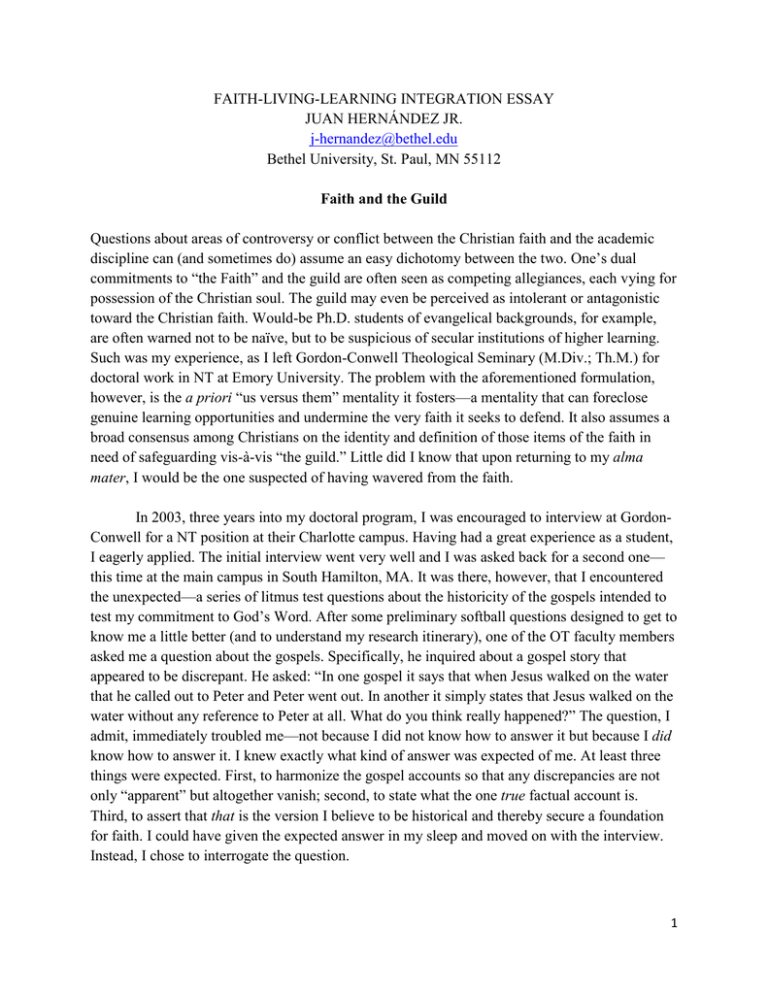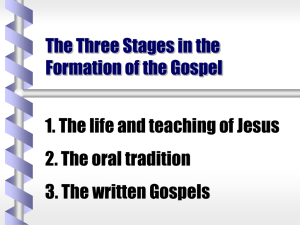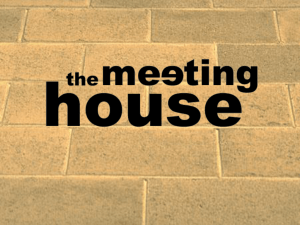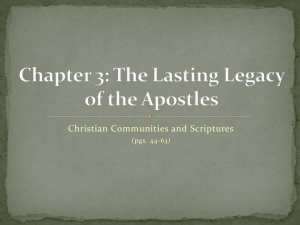Juan Hernandez (doc)
advertisement

FAITH-LIVING-LEARNING INTEGRATION ESSAY JUAN HERNÁNDEZ JR. j-hernandez@bethel.edu Bethel University, St. Paul, MN 55112 Faith and the Guild Questions about areas of controversy or conflict between the Christian faith and the academic discipline can (and sometimes do) assume an easy dichotomy between the two. One’s dual commitments to “the Faith” and the guild are often seen as competing allegiances, each vying for possession of the Christian soul. The guild may even be perceived as intolerant or antagonistic toward the Christian faith. Would-be Ph.D. students of evangelical backgrounds, for example, are often warned not to be naïve, but to be suspicious of secular institutions of higher learning. Such was my experience, as I left Gordon-Conwell Theological Seminary (M.Div.; Th.M.) for doctoral work in NT at Emory University. The problem with the aforementioned formulation, however, is the a priori “us versus them” mentality it fosters—a mentality that can foreclose genuine learning opportunities and undermine the very faith it seeks to defend. It also assumes a broad consensus among Christians on the identity and definition of those items of the faith in need of safeguarding vis-à-vis “the guild.” Little did I know that upon returning to my alma mater, I would be the one suspected of having wavered from the faith. In 2003, three years into my doctoral program, I was encouraged to interview at GordonConwell for a NT position at their Charlotte campus. Having had a great experience as a student, I eagerly applied. The initial interview went very well and I was asked back for a second one— this time at the main campus in South Hamilton, MA. It was there, however, that I encountered the unexpected—a series of litmus test questions about the historicity of the gospels intended to test my commitment to God’s Word. After some preliminary softball questions designed to get to know me a little better (and to understand my research itinerary), one of the OT faculty members asked me a question about the gospels. Specifically, he inquired about a gospel story that appeared to be discrepant. He asked: “In one gospel it says that when Jesus walked on the water that he called out to Peter and Peter went out. In another it simply states that Jesus walked on the water without any reference to Peter at all. What do you think really happened?” The question, I admit, immediately troubled me—not because I did not know how to answer it but because I did know how to answer it. I knew exactly what kind of answer was expected of me. At least three things were expected. First, to harmonize the gospel accounts so that any discrepancies are not only “apparent” but altogether vanish; second, to state what the one true factual account is. Third, to assert that that is the version I believe to be historical and thereby secure a foundation for faith. I could have given the expected answer in my sleep and moved on with the interview. Instead, I chose to interrogate the question. 1 I was disinterested in sinking the interview. Truly. What I was interested in was in demonstrating that the premise of the question was problematic—not because of any deep-seated desire to be a contrarian, but because it was misguided. I was being asked to turn the gospels into something they were not: data for historical reconstruction, which could then be cut into pieces and rearranged for the sake of one coherent account. More problematic than that, however, was the notion that the only proper foundation of faith resides in those historically verifiable events behind the gospels. Naturally, when the stories move in different directions—as they stubbornly do—the only recourse is to harmonize them so that “faith” may be safeguarded. The problem with that scenario, of course, is that whatever historical events lie behind the gospel stories have been transformed—sometimes radically—by the gospel writers into narratives that resist easy domestication. For me to ignore the issue now would surely spell trouble for me later. I attempted in various ways to illustrate the problem during the interview. First, I highlighted all the ways that the four gospels swung back and forth, sometimes wildly, between convergence and divergence in their various accounts. My hope was to demonstrate that a minor harmonization in one spot would throw the remaining narratives off kilter and demand that one continue to recalibrate each in a systematic manner. The end result would surely be a noncanonical—perhaps unrecognizable—single gospel narrative that flattens the rich, diverse and distinctive witness of the each individual gospel. I was unwilling to do that. My response, however, fell on deaf ears. I then moved on to a survey of the various approaches to the gospels in the history of biblical scholarship. I sought to illustrate that there was no one easy way to solve the complex dilemma presented by the gospels’ literary interrelationships and that to expect me to do so on the spot was at the very least unfair. I surveyed every major figure in NT scholarship—from Origen and Tertullian to Augustine and Calvin, reaching all the way up to Albert Schweitzer and Rudolf Bultmann. All of this, however, did not deter the interrogator and the question hung in the air. My final resort was to call on early church tradition and argue that by canonizing the four gospels—and rejecting both Marcion’s single, redacted gospel (Luke) and Taitain’s Diatessaron (harmony of the four gospels)—that the early church was in fact endorsing the distinctive witness of each gospel account, irrespective of the problems they might cause. Predictably, my response was deemed insufficient—if not duplicitous—and the question was repeated: “What really happened?” Finally, in exasperation, I flatly said, “I wasn’t there” and torpedoed the interview. The interview experience was a watershed moment. I realized then that I did not want to be part of any institution, including my beloved alma mater, where litmus test questions— premised upon a misappropriation of the scriptures and a fundamental misunderstanding of what faith in Christ is about—were allowed to call into question the legitimacy of one’s Christian scholarship. My mastery of both the primary sources in their original languages and the history of NT scholarship mattered little in this setting. Worse, they were liabilities; and my repeated attempts to demonstrate the complexity of the problem only confirmed my duplicity to the 2 interrogators. There was no room for ambiguity; no room for tension; no room for contradiction. Only a single, coherent and verifiable account, reconstructed on modern historicist principles, could serve as the proper basis for faith. Such an approach to faith, however, breaks apart on the reefs of the gospel stories very quickly. My interviewers seemed to be unaware of how pervasive the problems were—or that there were stories that were far more challenging than the one about Peter. The anointing at Bethany, for example, illustrates this quite easily. Did the anointing take place at the end (Mt, Mk, Jn) or near the beginning (Lk) of Jesus’ ministry? Was it in the house of Simon the Leper (Mt, Mk), Simon the Pharisee (Lk), or the house of Mary, Martha, and Lazarus (Jn)? Was Jesus’ head (Mt, Mk) or were his feet (Lk, Jn) anointed? Who complained about the anointing—some people (Mt), the disciples (Mk), Simon the Pharisee (Lk), or Judas Iscariot (Jn)? Was the complaint that the ointment could have been sold for charity (Mt, Mk, Jn) or that an unclean woman had dared to touch Jesus (Lk)? Did Jesus say “the poor you will always have with you” (Mt, Mk, Jn) or didn’t he (Lk)? Is the event an anointing for burial (Mt, Mk, Jn) or a story about forgiveness and redemption (Lk)? Even if we take a wide angle view and survey the larger narrative patterns of the four gospels, the difficulties persist. Did Jesus’ ministry last one year (Mt, Mk, Lk) or three (Jn)? Did he cleanse the temple at the end of his ministry (Mt, Mk, Lk) or at the beginning (Jn)? Did he minister first in Galilee and then go to Jerusalem (Mt, Mk, Lk) or did he oscillate regularly between the two (Jn)? Did he cast out demons (Mt, Mk, Lk) or didn’t he (Jn)? Did he speak in parables (Mt, Mk, Lk) or didn’t he (Jn)? How much time did he spend in Jerusalem toward the end of his ministry: a week (Mt, Mk, Lk) or six months (Jn)? Did he die after the Passover (Mt, Mk, Lk) or on the Passover (Jn)? Clearly, the material and formal differences among the four gospels do not commend the kind of historical reconstruction demanded of me. The assumption that the gospels could easily be harmonized without consequence was only one problem on display at the interview. The second was the assumption that history is about “what really happened.” History and “the past” functioned as equivalent terms for my interrogator. What this easy equation overlooks, however, are the interpretive dimensions of every form of history writing. There is no “past” to access without the agency of a human interpreter. As such, history is a distinctly human enterprise, a byproduct of human intelligence and the imagination—a fact that holds whether the account is written in the first, fifth, twelfth or twenty-first centuries. Every historical record is thus inevitably selective and explicitly interpretive. The frailties of historical memory and the proclivities of self-interest must, therefore, be taken seriously. To naively ask about “what really happened,” without taking these into account, is to court delusion. To demand that faith be based on such a claim is chutzpah. The irony is that the very gospels that resist facile reconstructions and domestication lend themselves quite readily to an examination of their creative and interpretive capacities. The 3 material in each is clearly structured in such a way as to highlight significant theological themes for the early Christian movement. Mark, for example, is fond of arranging his stories into an AB-A pattern for maximum rhetorical and theological effect. Five such stories occur throughout his gospel (3:19b-35; 5:21-43; 10:33-45; 11:12-25; 14:1-11). Mark typically begins by relating a story, breaks away from it to introduce a second story that he sees through to the end, and then returns to the original story. The result is the juxtaposition of stories that powerfully complement and contrast one another and create a rhetorical interface that reinforces important elements in Jesus’ teaching. The fact that Matthew and Luke will often fracture, prune, reverse, or eradicate Mark’s arrangement illustrates that their own theological agendas are pursued without regard for the modern historicist impulse. Matthew, for example, breaks up his gospel into five major teaching blocks that slow down and expand his gospel narrative (chpts. 5-7, 10, 13, 21, 24). Much of this material is drawn from Mark; a lot of it is new. Luke, on the other hand, inserts a ten-chapter travel narrative in the middle of his gospel that slowly traces Jesus’ movement to Jerusalem and contains a lot of additional teaching material, including ten new parables (10-19). John, on the other hand, never depicts Jesus uttering a parable and resists the urge to call Jesus’ deeds miracles. They are “signs,” pointing beyond themselves to greater significance, and only seven of these appear in John’s gospel—a number conspicuous for it symbolism. To this we may add that all of the “I am” sayings surface only in John. Matthew, Mark and Luke never record Jesus making an “I am” statement. What then does faith in Christ look like in the face of such literary, historical, and theological complexities—especially when the original stories have clearly been split, reconfigured, or combined with others so that what remains are refracted images of Jesus and his teachings? At the very least, dogmatism of any sort on this question is ruled out. This also seems to be one of the lessons of church history, which displays a variety of configurations for faith in Christ. Even the very faith expression I decried above as misguided (e.g. “faith” = belief in a single, historically verifiable version of an event), should be allowed its own particular expression in the name of Christian charity. So, what then does faith in Christ look like for me? Faith in Christ is about fidelity to the call of discipleship in each of the gospels. I regard the witness of the gospels—both individually and collectively—to be genuine reflections of Jesus’ life and ministry, mediated through the prism of faith. As such, some things that “really” happened are now obscured, inaccessible, or altogether missing. Others are rendered clearly— even more brilliantly—through that prism. As such, a faith that is predicated upon finding the historical Jesus first sets out to find the opposite of what the gospel writers gave us: the biblical Christ mediated through four distinct theological portraits. Their diverse patterns and creative configurations elucidate and confirm the inexhaustible significance of Christ. The pattern of discipleship replicated in each gospel, however, is the same: take up your cross and follow him. As such, the gospels are not only the truest witnesses to who Christ is, but are also the clearest expression of what faith in Christ is about: discipleship. 4 The irony of all of this is that it was at Emory—a representative of the guild par excellence—that I was exposed to the diversity, richness and complexity of the earliest Christian gospels; taught to appreciate their distinctive themes and theological contributions without fear; and equipped to identify and unmask every vestige of modernism that masquerades as “faith.” As such, I had wandered away from the faith—Gordon-Conwell’s. Teaching at a Christian University Succinctly put, my approach to teaching at a Christian university entails the discriminate use of every conceivable theoretical, methodological, and material advance for the elucidation of our common Christian identity through its artifacts and practices. Both the profane and sacred are to be mined for their usefulness. My cues are taken from Augustine, whose thoughts on learning from pagans are well known: But whether Varro’s account is to be accepted or not, we should not avoid music because of the superstition of the profane if we can find anything in it useful for understanding the Holy Scriptures…[and] we should not think that we ought not to learn literature because Mercury is said to be its inventor, nor that because the pagans dedicated temples to Justice and Virtue and adored in stones what should be performed in the heart, we should therefore avoid justice and virtue. Rather, every good and true Christian should understand that wherever he may find truth, it is the Lord’s.1 Since all truth belongs to God, no branch of knowledge is a priori ruled out of court as a means for discovering it. The mention of music, literature, justice, and virtue also highlights the importance of the liberal arts in Augustine’s life. In fact, what strikes me most about Augustine’s biography is how crucial the “liberal arts” were for his eventual Christian vocation.2 Although he often downplays (and even disparages) these in his Confessions,3 it is clear that Augustine’s rigorous training in the Latin classics—for example—endowed him with a rhetorical mastery of the language that was without peer and put to effective use for the cause of Christ. Augustine’s training in the liberal arts was even the standard against which to evaluate the thinking of others.4 This much is evident in his disappointment with Faustus, a highly esteemed figure among the Manichees, whom he had longed to meet.5 Once he met him, however, he observed: “What I found was a man ill-educated in the liberal arts, apart from grammar, and even in that schooled only to an average level.” 6 1 Doctr. chr. 2.18.28. (Robertson). Conf. 1.13.20; 3.6.11; 4.6.11; 4.14.21; 4.16.28. 3 Conf. 4.1.1; 4.16.30. 4 Conf. 7.6.8-9. 5 Conf. 5.3.3. 6 Conf. 5.6.11. (Boulding). 2 5 Augustine continued: [Faustus] had read a few of Cicero’s speeches and one or two books by Seneca, and some volumes fairly well written in Latin for his own sect, and because in addition to this he was accustomed to preach daily, he had acquired a fair command of language, which was rendered more glib and seductive by his skillful management of what ability he had and a certain natural charm.7 In other words, Augustine’s training in the liberal arts clearly enabled him to see through to the substance of an individual’s thinking. It was also on this basis that he admired Victorinus, whom he described as a man “thoroughly conversant with all the liberal arts,” who had “also read widely and with discrimination in philosophy and had taught many a noble senator”8—a sentiment that should resonate with all of us who teach the liberal arts at Bethel. Augustine’s training did more than simply equip him to speak eloquently or to discern the capacities of others, however. It also facilitated—even inspired—his theological thinking. Augustine’s reading of Cicero’s, Hortensius at an early age constituted a watershed moment that forever changed the character of his prayers to God and caused him to long “for the immortality that wisdom seemed to promise.”9 In fact, he would continue to allude to and quote from the Latin work for more than fifty years. To this we may add that the formulation of Augustine’s classic response to the problem of evil—a problem that had initially kept him from the faith— was clearly indebted to Platonic thought. Here, pagan learning paved the way for his theological answer to theism’s most virulent problem.10 Augustine, therefore, ably models an approach to learning that avails itself of every tool in the epistemological shed for the elucidation of our common Christian identity. Nothing appears to be off limits. It certainly leaves open the possibility that the “profane” will advance Christian thought. Augustine, thus, sets the precedent for the use of discipline-specific theories, methods, models, and materials of relevance to my own areas of teaching and research. In the arena of teaching, for example, students in my Readings in NT Greek and Advanced Greek Translation classes are taught not only to love and read the scriptures in the original language, but to attain a rudimentary understanding of linguistics (e.g. phonology, morphology, syntax, and semantics, historical and comparative linguistics). To be conversant in all these areas enables them not only to understand the Greek language better, but to relate it to the phenomenon of language more broadly. They are also exposed to non-biblical Greek, such as it is found both in the Patristic and pagan writers—an exercise that can solidify and deepen their mastery of the language and keep them from errors in the pulpit. Students in my Cultural World of the NT and 7 Conf. 5.6.11. (Boulding). Conf. 8.2.3. 9 Conf. 3.4.7-8. 10 Conf. 7.3.4-7.5.7; cf. 7.9.14; 7.20.26; 7.2.3. 8 6 Messianic Concepts are exposed not only to a large swath of biblical and non-biblical sources from the period in question (e.g. OT, NT, Apocrypha, Pseudepigrapha, Dead Sea Scrolls, Nag Hammadi Documents, Greco-Roman writings, Rabbinic sources, etc.), but also to the most recent socio-scientific models for the analysis of the ancient world. My ultimate goal here is to produce discerning readers of the NT, who are attuned to the various cultural cues embedded in the theological contributions of each NT writer. A student who learns how to read broadly and with expert sensitivity is unlikely to be misled by theological myopia. In my Issues in Biblical Studies course, students survey a battery of approaches to biblical interpretation that span two millennia. The Enlightenment features prominently in our discussions, as do the three quests for the historical Jesus. The most recent hermeneutical trends round out our discussions at the end of the course. Students, it is hoped, will come to understand the merits and limitations of the variety of available interpretive strategies and explore ways in which any one or more of these can be useful for the development and deployment of their own Christian hermeneutic. With a little guidance, the student should be able to mine the gamut of theoretical, methodological, and material options available for the elucidation of the scriptures and make the appropriate distinction between what feeds the imagination and what feeds the soul.11 The appropriate distinctions, however, are not easily made and the greater the breadth and density of material the student has to wade through the more difficult discernment can be. Principles, therefore, are necessary for clarity and direction. Augustine’s claim that love of God and neighbor should guide all biblical interpretation,12 therefore, is a useful principle for generating readings of scripture that are pastoral and faithful to the spirit of God’s word. Even some of the more recent hermeneutical trends that seek to recover the voices of those in the margins of the biblical text and continue to raise questions over the presence of sexism, slavery, genocide, etc. in the Bible can be seen as embodying the highest principles of love of God and neighbor. As such, even today’s postmodern and post-critical approaches to biblical interpretation should be profitably used to that end. Postscript: Professional Opportunities I have been incredibly fortunate to have experienced only opportunities during the pursuit of my professional activities. Since 2005, I have delivered a paper every year at the Society of Biblical Literature meetings. In 2008 I delivered two papers. Of the six papers I have delivered, two of them were invited presentations. Two of my papers were subsequently published in scholarly volumes; a third is forthcoming in the peer-reviewed Journal of Biblical Literature. In many respects, 2008 was a banner year, with my published dissertation even winning an award in Germany that came with a generous stipend. (The dissertation itself had been published in the Fall of 2006—six months after defending it. Eight reviews of it have been published in the U.S., 11 12 A distinction Augustine appeared to make repeatedly. See Conf. 3.4.8; 7.9.13-14; 8.21.27. Doctr. chr. 1.36.40. 7 England, and Germany to date). In 2009 I was invited to give a presentation at the Codex Sinaiticus Conference at the British Library in London. That presentation is slated for publication in a forthcoming volume of papers from the conference. In 2009 I was also invited to write three more articles for forthcoming volumes and I had another peer-reviewed article appear in New Testament Studies. So fast and furious have been the invitations that I am currently behind on a few obligations and have even had to turn down other offers, such as an opportunity to endorse a forthcoming Festschrift. Looking ahead, I am now scheduled to deliver another paper at SBL in 2010, my sixth consecutive year of presentations. The opportunities also include being invited to serve on various editorial committees. In 2008 I was invited to join the IGNTP (International Greek New Testament Project) committee and in 2009 I was invited to join the editorial board of the Editio Critica Maior volume on the Apocalypse. My research itineraries in the areas of textual criticism, early Byzantine interpretation, and the Apocalypse were a major factor in these invitations. In 2008 I also received a contract with Mohr Siebeck to produce a volume of six essays on Andrew of Caesarea’s seventh century commentary on the Apocalypse in the Studien und Texte zu Antike und Christentum series. I’d like to believe that all these opportunities are purely (!) a byproduct of the merit of my ideas. I acknowledge, however, that I have also benefited richly from the recent surge in popularity of textual criticism and perennial interests in the book of Revelation. The fact that I have also chosen to wade into an esoteric area like the manuscript tradition of the Apocalypse has allowed me to carve out a niche for myself where I essentially operate unencumbered. As a discipline, textual criticism tends to be stockpiled with either current or former evangelicals, all of whom maintain a high regard for the written word. A Christian practicing textual criticism is nothing new or controversial in the guild. Thus, I have faced little to no resistance as I have sought to explore my ideas or pursue my research itinerary. In fact—in an ironic twist—I have even caught the attention of the Orthodox community. In the Fall of 2009 I was interviewed about my faith and my role as a textual critic for Ancient Faith Radio, a podcast that serves Greek and Russian Orthodox Christians. At that time I was the only non-orthodox person interviewed for the podcast. Finally, my scholarship and Hispanic-American heritage also led to a recent invitation to teach a course on the gospels at Princeton Theological Seminary under the auspices of the Hispanic Summer Program (June 2010). The only problem I have faced is not having enough time to pursue every research opportunity that has come my way! 8

![Medieval Europe [1000-1500]:](http://s3.studylib.net/store/data/007874335_2-d7638f4faf65156dfdcac29a09a00993-300x300.png)






